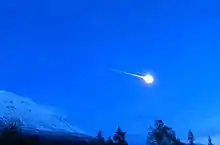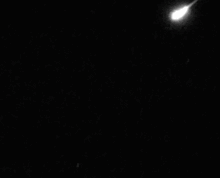Taurids
The Taurids are an annual meteor shower, associated with the comet Encke. The Taurids are actually two separate showers, with a Southern and a Northern component. The Southern Taurids originated from Comet Encke, while the Northern Taurids originated from the asteroid 2004 TG10, possibly a large fragment of Encke due to its similar orbital parameters.[4][5] They are named after their radiant point in the constellation Taurus, where they are seen to come from in the sky. Because of their occurrence in late October and early November, they are also called Halloween fireballs. Since 2P/Encke is such a short period comet, the meteors have the slowest impact speed of the annual well-known meteor showers.
| Southern Taurids (STA) | |
|---|---|
| Parent body | 2P/Encke |
| Radiant | |
| Constellation | Taurus |
| Right ascension | 03h 35m [1] |
| Declination | +14.4°[1] |
| Properties | |
| Occurs during | Sep 23 – Dec 8[1] |
| Date of peak | Nov 5 |
| Velocity | 27.7[1] km/s |
| Zenithal hourly rate | 5 |
| Northern Taurids (NTA) | |
|---|---|
| Parent body | 2004 TG10[2][3] |
| Radiant | |
| Constellation | Taurus |
| Right ascension | 03h 55m [1] |
| Declination | +22.8°[1] |
| Properties | |
| Occurs during | Oct 13 – Dec 2[1] |
| Date of peak | Nov 12 |
| Velocity | 29 km/s |
| Zenithal hourly rate | 5[1] |
Comet Encke and the Taurid complex are believed to be remnants of a disrupted 40-km-class comet from about 10,000 years ago,[6][7] breaking into several pieces and releasing material by normal cometary activity, mass loss via YORP spin-up, or occasionally by close encounters with the tidal force of Earth or other planets (Whipple, 1940; Klačka, 1999). In total, this meteoroid stream is the largest in the inner Solar System. Since the stream is rather spread out in space, Earth takes several weeks to pass through it, causing an extended period of meteor activity, compared with the much smaller periods of activity in other showers. The Taurids are also made up of weightier material, pebbles instead of dust grains.[8] The daytime showers are active from May to July (Beta Taurids and Zeta Perseids), while the nighttime showers are active from September to December.
Appearance
Typically, Taurids appear at a rate of about 5 per hour, moving slowly across the sky at about 28 kilometers per second (17 mi/s), or 100,800 km/h (65,000 mph).[8] If larger than a pebble, these meteors may become bolides as bright as the Moon and leave behind smoke trails.[8]
Due to the gravitational perturbations of planets, especially Jupiter, the Taurids have spread out over time, allowing separate segments labeled the Northern Taurids (NTA) and Southern Taurids (STA) to become observable. The Southern Taurids are active from about September 23 to December 8,[1] while the Northern Taurids are active from about October 13 to December 2. Essentially these are two cross sections of a single, broad, continuous stream in space. The Beta Taurids and Zeta Perseids, encountered by the Earth in June/July, are also cross sections of the stream that approach from the Earth's daytime side and, as such, cannot be observed visually in the way the (night-time) Northern and Southern Taurids of October/November can. Astronomers Duncan Steel and Bill Napier even suggest the Beta Taurids could be the cause of the Tunguska event of June 30, 1908.[9]
In 1962 and 1963, the Mars 1 probe recorded one micrometeorite strike every two minutes at altitudes ranging from 6,000 to 40,000 km (3,700 to 24,900 mi) from Earth's surface due to the Taurids meteor shower, and also recorded similar densities at distances from 20 to 40 million km (12 to 25 million mi) from Earth.[10][11]
The Taurid stream has a cycle of activity that peaks roughly every 2,500 to 3,000 years,[9] when the core of the stream passes nearer to Earth and produces more intense showers. In fact, because of the separate "branches" (night-time in one part of the year and daytime in another; and Northern/Southern in each case) there are two (possibly overlapping) peaks separated by a few centuries, every 3000 years. The next peak is expected around 3000 AD.[9]
The Taurids also have more frequent peaks which may result from a heavier concentration of material in the stream, which only encounter Earth during some passes.
Fireballs
Over Poland in 1995, all-sky cameras imaged an absolute magnitude –17 Taurid bolide that was estimated to be 900 kg and perhaps a meter in diameter.[12]
In 1993, it was predicted that there would be a swarm of activity in 2005.[8] Around Halloween in 2005, many fireballs were witnessed that affected people's night vision.[8] Astronomers have taken to calling these the "Halloween fireballs."[8] During the Southern Taurid meteor shower in 2013, fireball sightings were spotted over southern California, Arizona, Nevada, and Utah.[13] Mark Boslough and Peter Brown hypothesized that 2019 was to be a good year to check for a Taurid swarm that may even generate a concentration of daytime fireballs in June/July 2019. The Tunguska event may have been caused by a Beta Taurid.[14] A 2021 study by Ignacio Ferrín and Vincenzo Orofino catalogued 88 probable members of the swarm and showed that many such as the 2212 Hephaistos group and the 169P/NEAT group exhibit cometary activity.[15][16]

On November 11, 2019, a Taurid fireball was seen over St. Louis, MO.[18][19]
Meteor impact on the Moon
A brief flash of light from a lunar impact event was recorded by NASA scientist Rob Suggs and astronomer Bill Cooke on November 7, 2005, while testing a new 250 mm (10 in) telescope and video camera they had built to monitor the Moon for meteor strikes.[20] After consulting star charts, they concluded that the impact body was likely part of the Taurid meteor shower. This may be the first photographic record of such a strike, which some witnesses claim to have visually observed on rare occasions.[21]
References
- "Meteor Shower Calendar 2022-2023". American Meteor Society (AMS). Retrieved 2023-09-09.
- Meteor showers and their parent comets pg 470 by Peter Jenniskens
- Moore, Patrick; Rees, Robin (2011), Patrick Moore's Data Book of Astronomy (2nd ed.), Cambridge University Press, p. 275, ISBN 978-0-521-89935-2
- Beth Dalbey (24 October 2017). "Taurids Meteor Shower Fireballs: Peak Dates, What To Expect". Retrieved 11 November 2017.
- Porubčan, V.; Kornoš, L.; Williams, I. P. (June 2006). "The Taurid complex meteor showers and asteroids". Contributions of the Astronomical Observatory Skalnaté Pleso. 36 (2): 103–117. arXiv:0905.1639. Bibcode:2006CoSka..36..103P. Retrieved 29 July 2017.
- Ye, Quanzhi; Jenniskens, Peter (2022). "Comets and meteor showers". arXiv:2209.10654 [astro-ph.EP].
- Babadzhanov, P. B.; Williams, I. P.; Kokhirova, G. I. (2008). "Near-Earth Objects in the Taurid complex". Monthly Notices of the Royal Astronomical Society. 386 (3): 1436–1442. Bibcode:2008MNRAS.386.1436B. doi:10.1111/j.1365-2966.2008.13096.x.
- Dr. Tony Phillips (2005-11-03). "Earth is orbiting through a swarm of space debris that may be producing an unusual number of nighttime fireballs". NASA Science News.
- Meteor Shower Promises Seven Shooting Stars an Hour – National Geographic News (November 7, 2003)
- Robbins, Stuart (2008). ""Journey Through the Galaxy" Mars Program: Mars ~ 1960-1974". SJR Design. Retrieved 2014-01-26.
- Mihos, Chris (11 January 2006). "Mars (1960-1974): Mars 1". Department of Astronomy, Case Western Reserve University. Archived from the original on 13 October 2013. Retrieved 2014-01-26.
- Meteor showers and their parent comets pg 467 by Peter Jenniskens
- Sky News US Team (2013-11-07). "Meteor 'Fireball' Lights Up California Sky". news.sky.com. London, UK: BSkyB. Retrieved 2013-11-07.
- Joel Achenbach (2018-12-25). "Incoming! A June meteor swarm could be loaded with surprises". www.washingtonpost.com. Washington DC, US. Retrieved 2019-05-04.
- Ferrín, Ignacio; Orofino, Vincenzo (November 2021). "Taurid complex smoking gun: Detection of cometary activity". Planetary and Space Science. 207: 105306. arXiv:2011.13078. Bibcode:2021P&SS..20705306F. doi:10.1016/J.PSS.2021.105306. ISSN 0032-0633. S2CID 227210565. Wikidata Q108888402.
Using the Secular Light Curve (SLC) formalism (Ferrín, 2010), we have catalogued 88 probable members of the Taurid Complex (TC). ... This high percentage of active asteroids gives support to the hypothesis of a catastrophe that took place during the Upper Paleolithic (Clube and Napier, 1984).
- Romero, James (2021-09-30). "Swarm of Near-Earth Comets Linked to Recent Ice Giant Breakup". Discover. Archived from the original on 2021-10-14. Retrieved 2021-10-14.
Together, their orbital analysis of bodies increased the complex's membership from half a dozen to 88. ... The findings are welcomed by those who believe Comet Encke and the other products of this astronomical event are responsible for many of Earth's most violent and consequential impacts over the last 20,000 years.
- Norsk meteornettverk (2020-12-04). "Flott nordlig tauride sett i Troms og Finnmark". norskmeteornettverk.no. Retrieved 2020-12-06.
- "Bing video". www.bing.com.
- Perlerin, Vincent (12 Nov 2019). "Fireball spotted over Missouri on Nov. 11th, 2019". American Meteor Society. Retrieved 18 September 2022.
- BBC News: Nasa team sees explosion on Moon (3 January 2006)
- "An Eyewitness Impact Debunked". Archived from the original on 2001-04-22.
Further reading
- Klačka, Jozef (1999). "Meteor Streams of Comet Encke. Taurid Meteor Complex". Abstract
- Whipple, F.L. (1940). "Photographic meteor studies. III. The Taurid shower." Proc. Amer. Phil. Soc., 83, 711–745.
External links
- November 2008 Taurid Meteor Fireballs
- Taurid Meteors To Peak Monday
- Fireball Sightings – NASA
- Scientific articles pertaining to the Taurid complex
- Northern Taurids (NTA) for 2012 (Maximum: November 12; ZHR = 5; V = 29 km/s)
- Southern Taurids (STA) for 2012 (Maximum: October 10; ZHR = 5; V = 27 km/s)
